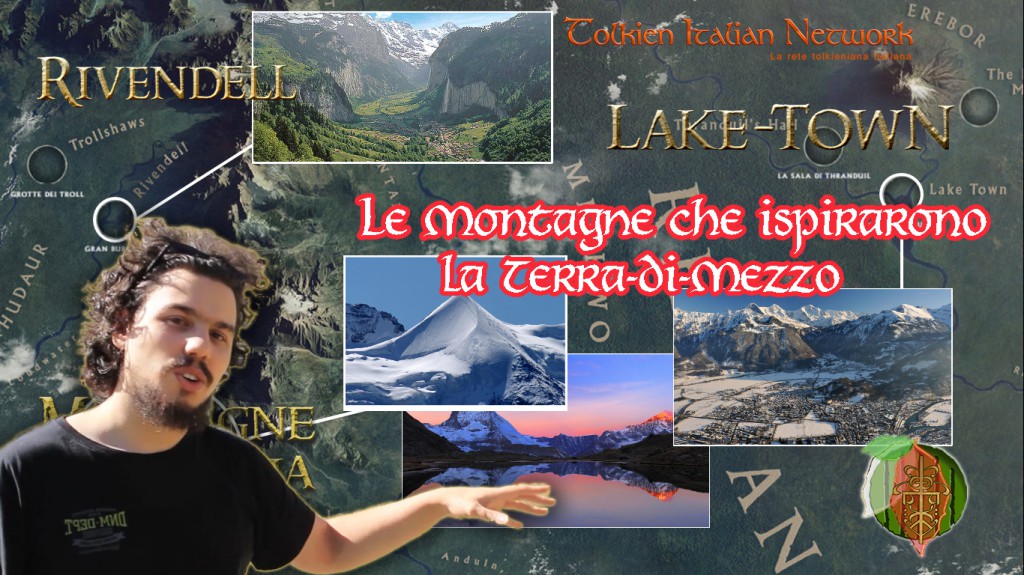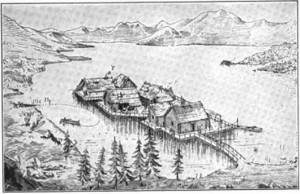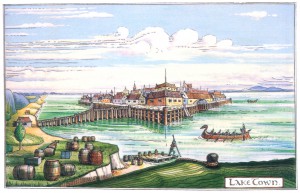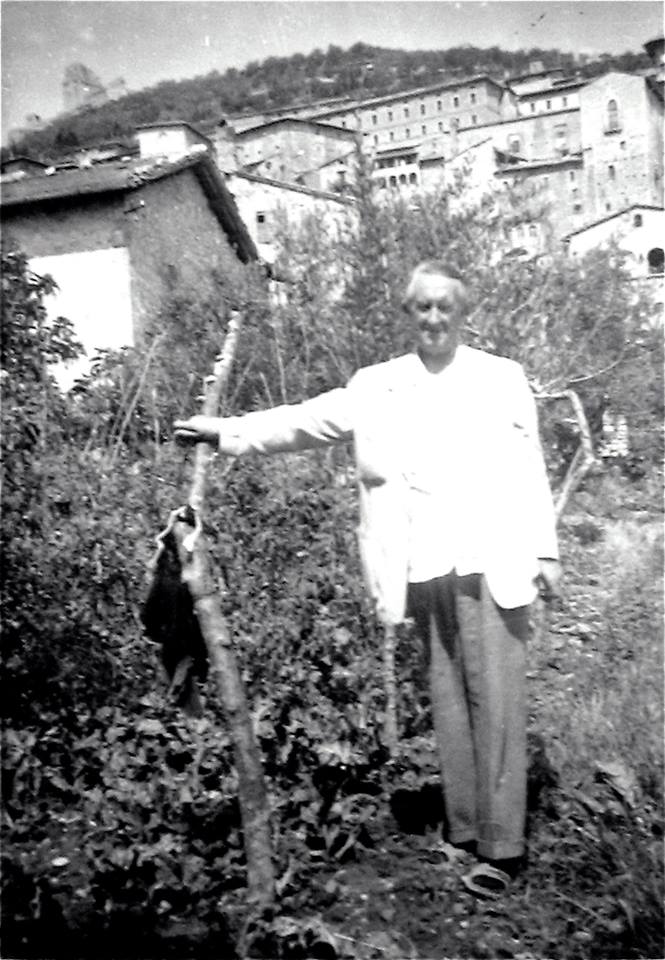
News from Bree
spymaster@theonering.net
Nov 15 2014, 2:39am
Post #1 of 1
(842 views)
Shortcut
|
|
Tolkien and Italy, through Switzerland and the FanContest
|
Can't Post
|
|
In our latest Library piece, TORn reader and Tolkien Italian Network member Gabriele Marconi explores how a 2 minute video doesn't pay full tribute to a fans love of Tolkien.
Gabriele told TORn, "The point is that a 2-minute time video could not contain nor the smallest part of the reasons why Tolkien is so strongly related to Italy and the Alps, the mountains we know so well (even if Tolkien went through them only from the Swiss side). That is also why Italy is Middle-Earth, or at least a part of it, "Gondor", as the very one John Ronald used to say. So I choosed to speak about the famous postcards of Der Berggeist and used them as a spark to tell more about the relations between Tolkien, Switzerland and Italy. Not only the postcards: every opened issue has been deepened in the shape of Q&A"
The article is translated from Italian to English by Greta Bertani.
A contest challenges my passion for J.R.R. Tolkien: the sense of admiration

Preview - The mountains giving the inspiration for Middle-Earth
Well, it's difficult not to participate to a contest to find out the ultimate admirer of Peter Jackson's The Hobbit trilogy, when you're the first person trying to study it in connection with the literary work it is (many prefer to say "it should be") based upon. For sure this chance is well enough to decide to give it a try: going through the landscapes that gave Middle Earth its most famous and admired appearance, and, moreover, the possibility to participate to a private show of this third part a whole month before it comes in cinemas. The whole thing is specially tempting if you will have the chance to have a chat with the one, who, one more time, engaged himself in this adventure, bringing Tolkien on the big screen. Nonetheless, traveling around in half northern Italy has forced me to ask myself which is the real sense of admiration, that is to say why something deserves to be admired: because knowledge is priceless and never-ending. In the very same way it happens to me, it can happen to others.
So? If something is in very truth beautiful, to the extent that it is admired, you want to go and tell it in the streets, tell it to everybody. "Well, this looks like something that fits the Tolkien Italian Network!" I said to myself. I asked the editorial staff, got a positive answer and, here I am on my way to the Matterhorn. Not all people of the TIN editorial staff are fond of Jackson's work, but we all know that this challenge can be very important for all Tolkien lovers, as it was between 2001 and 2003-04: it originated a wave from which everyone benefited, even those who savagely criticized him, and it lasted years.
No way to conceal it, I always speak well about him. Contrary to your belief, I read Tolkien even before Peter Jackson's movies; but I'd lie, if I denied what I owe to the kiwi director, since the very first frames of The Fellowship of the Ring were played. My comprehension of the literary work owes much to the The Lord of the Rings film, both to those parts that are closer and to those that differ from the book. This, most of all, I acknowledge to Peter Jackson: not that his plot emphasizes Tolkien's books as they are, but that they are the attempt (of a man, the director) of reading them, and of challenging the viewers to verify how the literary plot tells an event, what it tells us, and furthermore to discover the ideas underlying it. Intentionally or as a consequence it is a strong suggestion to reading, that leads the reader to consider the text and what lies beneath, both the steps that proceed together, and mostly when the film forks for a while or definitively. In these days I've also had a little satisfaction: a scholar of unquestionably great stature such as Thomas Honegger has said a few words about the films; his words do not differ much from the ones I wrote some time ago.
Taking part to a Fan-Contest is a far different challenge. Those who know me a little, will surely know that "fan"¯ is a word I'd like to erase from English dictionaries (with the hope that it will never be written in Italian ones. I am convinced that Tolkien would be in complete accord with me). Anyway, sometimes you have to compromise about language, also and especially because Jackson himself gave the contest its sense. Then, "fellowship" redeems almost every word in the title.
After watching the video that outlines so precisely the competitors, well, I claim the right to participate as passionate, that is to say, someone (according to its etymology) who let himself to be so involved by the fascination of an encounter, that he is willing to suffer for it (in this particular case, Jackson wisely puts Tolkien before his films). And which reading of Tolkien's books and, I would add, watching Jackson's films, could ever give joy without a considerable and not occasionally throbbing pain?
Well, here I am. I wanted to say a lot and 2 minutes is a short time: I decided time was too short not to say something really useful, something so useful it could outlive the contest and that, could, maybe, help some beginner to understand Tolkien's work a little more. Following the outline was simple and remembering the film location was extremely unsatisfactory. In addition Jackson himself has suggested to look at Tolkien, prior to (looking at) himself. A task harder than the outline, if one considers that the Rules contain some provisions to be avoided when talking about Middle-Earth geography. It had not to be short of a certain taste of Italy.
"Well, I will go
at the foot of Mount Matterhorn!
I will tell about that mountain (I love so much) that Tolkien put in his works,
and that he could see well before imagining his Middle-Earth."
Explaining the video, how many issues arisen!
I will not bother you, telling you how I avoided the restrictions in the contest regulations (if someone is interested in such boring matters, he can always read the description on Youtube). You should indeed be interested to know that I was not completely honest to you... But, really!, 2 minutes forced me to simplify things.
There's another reason, too. You know, by now, that TIN encourages its readers to take further and harder steps. This time is the same, too. I have indeed used a moment in Tolkien's life, told in some of the most important works, that is, in fact, a biography summarising.
1. Tolkien saw Josef Madlener's Der Berggeist in 1911 or, did he buy some postcards representing it in that same year?
No. The episode is told in Humprey Carpenter's A Biography, the most important biography, but it's one of the most contested hypothesis. In fact, the daughter, Julie Madlener, asserted that the drawing was not complete until 1925-6, while the author of a treatise about Madlener leaves a wider time margin, up to 1930. The postcard with this drawing came in Tolkien's hands only after 1935, year in which the series of those postcards was printed. The interview with Madlener's daughter and the discussion about the historical accuracy of the episode, is referred to in Manfred Zimmermann's article The Origin of Gandalf and Josef Madlener, Mythlore # 34 (1983), while in the revised and expanded edition (2002) of The Annotated Hobbit by Douglas A. Anderson the amendment is described in a short note.
So why, states Carpenter, Tolkien kept the postcard together with some notes clearly meaning that his Swiss journey was related to it and why, if the postcard was published much later (not only following his creation, but the invention of Gandalf's name too), Tolkien wrote on it "Origins of Gandalf"? John D. Rateliff (The History of the Hobbit, 2007) identifies at least one moment, in which there could have been a direct influence: Gandalf's hat drawings, dated 1936-7, but, clearly, things do not match.

Gandalf's hat: left (and before) in a drawing representing him at the threshold of Baggins' Home; right (and afterwards) in: The Three Trolls are turned to Stone.
It will be clear to you that two minutes are not even enough to introduce the issue. Anyway, in such an article like this gaps can be filled.
2. Which Swiss places are represented in a Middle Earth map? Did they all give inspiration for the relevant mentioned places?
Swiss Day trips and landscapes Tolkien lived and saw in 1911 were at the basis of many mountain adventures told in his works. In Letter #306 to his son Michael and in #232 to Joyce Reeves Tolkien clearly says that Thorin's Fellowship adventures on the Misty Mountains originate exactly from his own during that journey in 1911. In the letter to Michael, Tolkien describes the Silberhorn (2nd mountain to appear on the map) as "the Silvertine of my dreams", Celebdil, Zirakzigil, the mountain where Gandalf slayed the Balrog, died and came back from death. The first mountain is the Matterhorn (our Monte Cervino) from the Swiss side, that surely inspired the frightful Caradhras, Redhorn repulsing the Fellowship of the Ring: an inspiration that is mainly linguistic, as it appears in Tolkien's note in HoME VIII - The Treason of Isengard, taken into account in Parma Eldalamberon 17:
"Caradhras seems to have been a great mountain tapering upwards (like Matterhom), while Celebdil was simply crowned by a smaller pinnacle."
As to Rivendell and Lake-town, it is difficult not to think to Tolkien's stay in the Jungfrau massif's pleasant towns. The Lauterbrunnen valley (3rd picture) and Interlaken city (4th picture) between the Thun and Brienz Lakes, its ship canals seem more than a simple fascinating idea. The issue is further discussed in Marie Barnfield's Roots of Rivendell, Te Lyfe ant te Auncestrye (1996). It is also advisable to live the holiday proposed by the Tolkien Tour with Alex Lewis.
Comparisons with Swiss localities

On the Left of Image: The Mountains of Moria, the Celebdil and Caradhras, the "Silvetin of his dreams" and Redhorn, were really seen by Tolkien. And probably also Mirrormere. On the Right of Image: In the area of the Jungfrau massif, the Lauterbrunnen valley is a crack in Mount Schwarzer Mönch, a wide gorge in which 72 waterfalls fall. Goethe was struck by it more than 130 years before Tolkien. Tolkien, as can be seen in his famous picture, used it as a model for Imladris, Rivendell, since the very first writing of the Hobbit. (A former Italian translation of the Hobbit, used the name "Forraspaccata" that means, in fact, "cracked gorge").
There could also be an archaeological reference for Lake-Town, setting Middle-Earth and the Hobbit in an imaginary, but very realistic past, a theory developed thanks to Tolkien's artistic ability. At first Christina Scull in The Influence of Archaeology and History (1993) and then, together with Wayne Hammond (Artist and Illustrator, 1995), then Rateliff (see above) referring to the half-submerged pillars of Old Esgaroth and the description of wooden platforms under-laying the Town, traced back to a certain familiarity of Tolkien with the discoveries of Stone-Age lake-dwellings: the towns at first discovered right in Switzerland (1854), and the first views modeled in Ferdinand Keller's reconstructions, heavily revised in the days when the Hobbit was written. The pictures in which the link is clearer are Lake-Town, Esgaroth and Death of Smaug.

One of the pictures of J.M. Tyler's book The New Stone Age in Northern Europe (1921), according to Michael Martinez it is one of the texts on the matter which are closer to Lake-Town Tolkien's descriptions.
 J.R.R. Tolkien's Lake-Town. J.R.R. Tolkien's Lake-Town.
3. Was Tolkien the first one to compare Italy and Middle-Earth?
Literally, the first recorded.
At the end of July 1955, Tolkien visits Italy with his daughter Priscilla, while his wife Edith cruises the Mediterranean Sea. Although a short glimpse is given in Biography and in the Letters, the majority and most beautiful part of this information comes from Hammond&Scull's The J.R.R. Tolkien Companion and Guide, containing passages of that diary Tolkien wrote from the beginning of August (one of his most desired unpublished documents) and letters never published in other works. In a letter dated 28th July to a family friend Jennifer Brookes-Smith, who called Tolkien "uncle", he shows us right from the beginning of the letter to what extent the Italian landscape left a burning impression on him. Just while he was requested to proofread The Return of the King (it was going to be published on the following 20th October) and he was in the middle of the writing of the Appendixes, he describes Venice as the ancient Pelargir in the times of Nśmenor, full of elvish-looking ships, because the shadow was not fallen on Men of Westernesse, yet. Assisi, the place in Italy that set off very strong feelings in him, became Lossarnach, the "Vale of Flowers", a hill region caressed by sea winds, and with a flourishing fruit agriculture, laying south of Minas Tirith and of the White Mountains. After this journey Tolkien used to talk about Italy with the name of Gondor, a recurring mention in the letters of the following months. He also longed for "the heart of Christendom", and he defined himself "an exile from the borders and far provinces returning home, or at least to the home of his fathers." He fell in love with the Italian language, discovered once again; he said he wanted to learn it better.
Major works that reconstruct Tolkien's journey in Italy:
- Michaėl Devaux, Le gondole di Gondor: il viaggio di Tolkien a Venezia (1955), I quaderni della Contea 3, 2005 [Gondor gondolas: Tolkien's journey in Venice]
- P. Guglielmo Spirito O.F.M. Conv., Il viaggio di Tolkien ad Assisi, I quaderni della Contea 1, 2003, published again in Lo Specchio di Galadriel, 2006. Reconstructions were made with the help of Priscilla Tolkien [Tolkien's journey to Assisi].
 Tolkien during his stay in Assisi Tolkien during his stay in Assisi
In the following years, too, Tolkien harboured his affection for Italy, and insisted on the relationship between our country and Middle-Earth. In September 1966 Edith and him repeated the voyage on the Mediterranean Sea, but this time they sailed among the Eolian Islands. Tolkien could admire Stromboli's flare up, during an evening on the Thyrrenian Sea. In the almost legendary #19 (December 1968) of the review Niekas of the Tolkien Society of America (later enclosed to Mythopoeic Society), we can find Tolkien's interview-chat with his friends Clyde S. Kilby and Dick Plotz, Many Meetings with Tolkien. Here he stated that "he'd never seen anything that looked so much like Emyn Anar". This name cannot be found elsewhere in his works, and could refer to Mordor's hills surrounding Mount Doom, maybe its secondary peak-craters.
According to Tom Shippey (Preface to the Italian edition of The Road to Middle-Earth), Tolkien was still thinking to the Umbrian and Tuscanian country while he wrote Book IV of The Lord of the Rings, because Ithilien reminds it almost unmistakably. Verlyn Flieger (Preface to the Italian edition of Splintered Light) keeps a vivid remembrance of Italian and Roman light, and compares it to the splendour and light shades in the Silmarillion; each Italian passionate should learn this preface by heart. Not only the major scholars, but many, even if less famous, fell in love with Italy and very often describe it as it were Middle-Earth.
Italy has good reasons to be Middle-Earth, or a part of it, at least as much as England and New Zealand.
P.S.: Why did I not talk about all this in the video, but, I talked about Switzerland, instead? You should try to refer all this solely using the place names in Peter Jackson's hobbit!
4. Are you really the author of the only critical study about Peter Jackson's Hobbit?
Big word is author (I did not use it), but as far as I know I am the only, who has spread at least parts of a dissertation about the relationship between The Hobbit movie and Tolkien's works, nor works have been published, be they full books or essays in a collection. Some Tolkien experts contributed to the public understanding of the film, but nothing with the intention of writing a essay. Of course, this does not certify any credit for my pages Lo Sguardo di Tolkien ne Lo Hobbit di Jackson (Tolkien's gaze in Jackson's Hobbit). This work is unique as a matter of fact: it's the only one.
SEE THE ESSAY ON MEDITAZIONI TOLKIENIANE
Only the first three chapters are available. Soon they will be revised and completed with quotations and comparisons from Tolkien scholars. I will carry it on as soon as I have finished some connected stuff.
If, even with my explanations, this video does not mean much to you, I am sure it's worth to watch it again. I'd like to thank Edoardo for the soundtrack: he gave me permission to use one of his magnificent compositions, Il Canto del Mattino (The morning song) that, as you can see reading the second page, perfectly fits an Italian application. Here follows his introduction.
Edoardo Volpi Kellerman's music
The morning song is a piece of music, with very ancient origins, of which I dared a critical re-writing, using a modern polyphonic style. At the same time I tried to preserve the atonal feature of the music of that time. It was played each morning, during the Sunrise ceremony, in the watch-tower citadel of Minas Tirith.
It was orally preserved until King Elessar, then it was transcribed in neumes, using a writing that was so similar to the medieval one, that I could obtain an historically plausible transcription.
In the manuscript, a line in High Elven is written next to the text line.
To the Rising Sun
0:00 - 0:30
Anar Ortolan
Across mountains and valleys
0:31 - 1:04
I Orontin Ar I Nandin
To the Children of Osgiliath
1:04 - 1:36
I Hinin Osto Elenion
farewell to the Walls and to the Ancient Kings
1:37 - 2:04
Suilie Rambain Ar I Yare Aranin
A Nimloth
2:05 - 2:42
Ninqueloten
The music on Spotify.
(This post was edited by Altaira on Nov 15 2014, 7:50pm)
|












